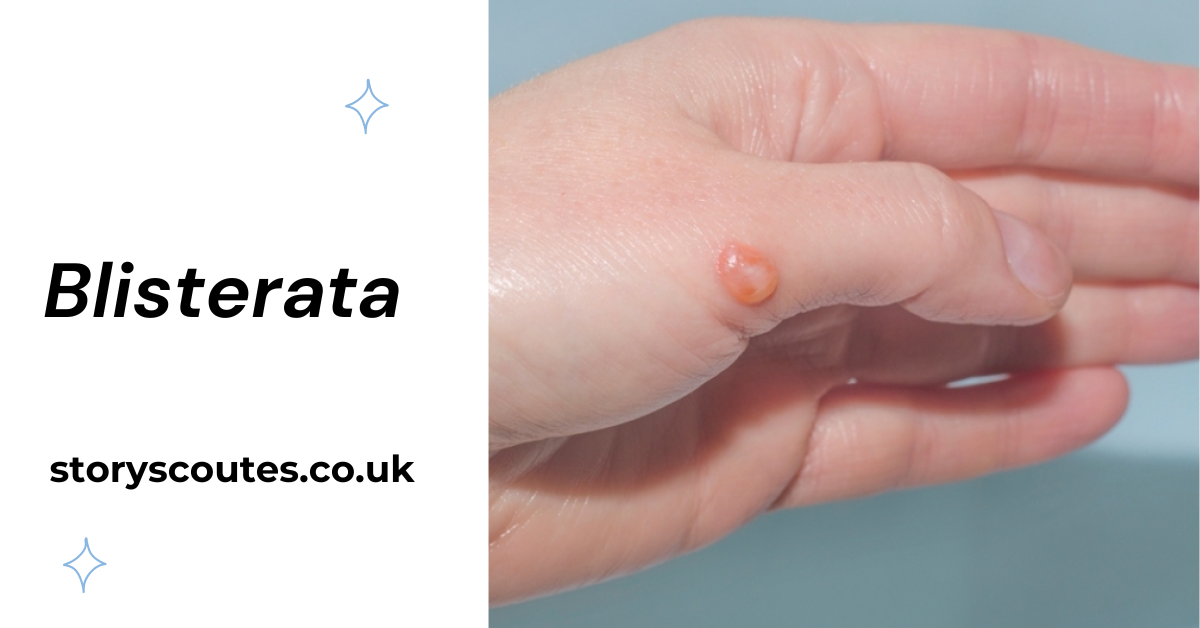Blisterata – Understanding the Phenomenon
Introduction
Welcome to our comprehensive guide on Blisterata. This term, which may be new to many, has fascinating applications in both medical and digital contexts.
Whether you’re curious about skin blisters or intrigued by digital trends, this article will provide detailed insights, easy-to-understand explanations, and original interpretations. Let’s dive into the world of Blisterata!
What is Blisterata?
Blisterata is a term with two primary meanings:
- Medical Context: Refers to conditions causing blisters on the skin.
- Digital Context: Describes phenomena that spread quickly and widely online.
Understanding Blisterata in these contexts helps us grasp its significance and implications.
In the medical context, Blisterata encompasses a range of conditions where the skin develops fluid-filled pockets, known as blisters.
These can result from infections, autoimmune diseases, or physical trauma. Blisters act as a protective barrier, preventing further damage to the skin and allowing the underlying tissue to heal. However, they can be painful and inconvenient, often requiring medical intervention for proper management.
In the digital realm, Blisterata metaphorically describes situations or trends that spread rapidly across the internet. This could include viral videos, memes, or social media challenges that gain widespread attention in a short period.
Also Read: Your Vision Can Predict Dementia
Similarly, cybersecurity threats like malware or phishing attacks can proliferate quickly, impacting numerous users or systems. Understanding Blisterata in this context involves recognizing the dynamics of digital virality and the challenges associated with managing such rapid dissemination.
By examining Blisterata from both medical and digital perspectives, we gain a comprehensive understanding of how rapid spread and impact can manifest in different areas of life. This dual exploration not only broadens our knowledge but also highlights the importance of effective management and response strategies in both fields.
Blisterata in Medicine
Causes of Blisterata
Blisters can form on the skin due to various reasons:
- Infections: Viral infections like herpes and bacterial infections like impetigo can cause blisters.
- Autoimmune Diseases: Conditions like pemphigus and bullous pemphigoid occur when the immune system attacks the skin.
- Physical Trauma: Burns, friction, or exposure to harsh chemicals can lead to blisters.
Blisters, medically known as vesicles or bullae depending on their size, are fluid-filled lesions that can appear on the skin due to a variety of factors. Infections are a common cause; for instance, the herpes simplex virus (HSV) causes painful blisters around the mouth or genital area. Similarly, chickenpox and shingles, both caused by the varicella-zoster virus, lead to blistering rashes. Bacterial infections like impetigo, often seen in children, result in blisters that rupture and form a honey-colored crust.
Autoimmune diseases are another significant cause of blisterata. In conditions like pemphigus and bullous pemphigoid, the body’s immune system mistakenly attacks the skin, leading to blister formation. These diseases can be chronic and require long-term treatment to manage symptoms and prevent complications.
Physical trauma, including burns, friction from tight shoes or repetitive activities, and exposure to irritants like poison ivy or harsh chemicals, can also cause blisters. These blisters serve as a protective mechanism, isolating the damaged tissue from further harm and allowing the underlying skin to heal.
Understanding the various causes of blisterata is crucial for effective diagnosis and treatment. Each cause requires a different approach, whether it’s antiviral medication for infections, immunosuppressants for autoimmune conditions, or protective measures to prevent friction and trauma.
Symptoms and Diagnosis
Blisterata in a medical context presents as fluid-filled pockets on the skin, often accompanied by:
- Redness
- Itching
- Pain
Diagnosis typically involves:
- Physical Examination: A doctor examines the affected area.
- Laboratory Tests: Blood tests, skin biopsies, or cultures help identify the cause.
Blisters are easily recognizable as raised, fluid-filled lesions that can vary in size from small vesicles to large bullae. They are often accompanied by redness and swelling, and may be itchy or painful depending on their cause and location. For instance, blisters caused by herpes simplex virus (HSV) are typically painful and can be preceded by a burning or tingling sensation.
Also Read: Chad Ames Obituary Syracuse NY
To diagnose the underlying cause of blisterata, healthcare providers start with a detailed medical history and physical examination. They will inquire about recent activities, exposures, and any associated symptoms like fever or fatigue. The appearance and distribution of the blisters can provide clues; for example, blisters in a linear pattern might suggest contact dermatitis, while widespread blisters could indicate an autoimmune condition.
Laboratory tests play a crucial role in confirming the diagnosis. Blood tests can detect antibodies or signs of infection, while skin biopsies allow for microscopic examination of the affected tissue. Cultures from blister fluid can identify bacterial or viral pathogens. In some cases, specialized tests like direct immunofluorescence are used to detect specific autoimmune markers.
Accurate diagnosis is essential for effective treatment and management. Misdiagnosis can lead to inappropriate treatments that may worsen the condition or delay recovery. By combining clinical evaluation with laboratory testing, healthcare providers can pinpoint the exact cause of blisterata and tailor their treatment approach accordingly.
Treatment and Management
Treating Blisterata depends on its cause:
- Topical Treatments: Antibiotic ointments or corticosteroid creams.
- Oral Medications: Antiviral drugs, antibiotics, or immunosuppressants.
- Preventive Measures: Avoiding triggers and maintaining good skin hygiene.
The treatment of blisterata varies depending on the underlying cause and severity of the condition. Topical treatments are commonly used for localized infections and mild cases. For bacterial infections like impetigo, antibiotic ointments can be applied directly to the affected area to eliminate the infection and promote healing. Corticosteroid creams are effective for reducing inflammation and itching in cases of allergic reactions or autoimmune diseases.
Oral medications are necessary for more severe or widespread blisterata. Antiviral drugs like acyclovir are prescribed for herpes simplex virus (HSV) infections to reduce the duration and severity of outbreaks. In cases of bacterial infections, oral antibiotics are used to clear the infection from the body. Autoimmune diseases like pemphigus and bullous pemphigoid often require immunosuppressants or corticosteroids to control the immune system’s attack on the skin and prevent new blisters from forming.
Preventive measures are crucial in managing blisterata, especially for recurrent conditions. This includes identifying and avoiding known triggers, such as allergens or irritants. Good skin hygiene, including regular cleaning and moisturizing, helps maintain the skin’s barrier function and prevent infections. Wearing protective clothing and using appropriate footwear can reduce friction and pressure on the skin, minimizing the risk of blisters from physical trauma.
In some cases, supportive care is necessary to relieve symptoms and promote healing. This might include using bandages to protect blisters from further damage, applying cold compresses to reduce swelling and pain, and taking over-the-counter pain relievers. For chronic or severe cases, ongoing medical supervision and adjustments to the treatment plan are often required to achieve optimal results.
Common Conditions Associated with Blisterata
Several conditions can cause Blisterata:
- Herpes Simplex Virus (HSV): Causes cold sores and genital herpes.
- Chickenpox and Shingles: Caused by the varicella-zoster virus.
- Contact Dermatitis: An allergic reaction to substances like poison ivy or nickel.
Herpes simplex virus (HSV) is one of the most common causes of blisterata. There are two types of HSV: HSV-1, which typically causes cold sores around the mouth, and HSV-2, which primarily causes genital herpes. Both types result in painful, fluid-filled blisters that can recur periodically. Antiviral medications can help manage outbreaks and reduce transmission.
Also Read: Lexi Bonner Footage – Video Guide In 2024
Chickenpox and shingles are caused by the varicella-zoster virus. Chickenpox is a highly contagious disease that primarily affects children, characterized by an itchy, blistering rash. Shingles, or herpes zoster, occurs when the dormant virus reactivates later in life, causing a painful rash with blisters along nerve pathways. Vaccination is an effective preventive measure for both chickenpox and shingles.
Contact dermatitis is another common cause of blisterata. This condition occurs when the skin comes into contact with an allergen or irritant, leading to an inflammatory reaction. Common triggers include poison ivy, nickel, latex, and certain skincare products. The resulting blisters are often accompanied by redness, itching, and swelling. Treatment involves identifying and avoiding the trigger, as well as using topical corticosteroids to reduce inflammation.
Other conditions associated with blisterata include autoimmune diseases like pemphigus and bullous pemphigoid, as well as infections like impetigo and hand-foot-and-mouth disease. Burns, both from heat and chemicals, can also cause blisters. Each condition requires a specific treatment approach based on the underlying cause and severity.
Living with Blisterata
Managing Blisterata involves:
- Education: Learning about triggers and symptoms.
- Support: Seeking support from healthcare providers and support groups.
- Lifestyle Adjustments: Adapting daily routines to minimize discomfort.
Living with blisterata can be challenging, especially for individuals with chronic or recurrent conditions. Education is a key component of effective management. Understanding the specific triggers and symptoms of blisterata allows individuals to take proactive steps to prevent outbreaks and manage symptoms. This might involve avoiding known allergens, wearing protective clothing, and practicing good skin hygiene.
Support from healthcare providers is essential for managing blisterata. Regular check-ups with a dermatologist or primary care physician help monitor the condition and adjust treatment plans as needed. In addition, support groups and online communities can provide valuable emotional support and practical advice from others experiencing similar challenges.
Lifestyle adjustments are often necessary to minimize discomfort and improve quality of life. This might include using specialized skincare products to protect and moisturize the skin, avoiding activities that cause friction or pressure on the skin, and making dietary changes to reduce inflammation. For individuals with autoimmune blistering diseases, stress management techniques like meditation or yoga can help reduce the frequency and severity of outbreaks.
Overall, a comprehensive approach to managing blisterata involves a combination of medical treatment, preventive measures, and lifestyle adjustments. By staying informed and proactive, individuals with blisterata can lead fulfilling lives despite the challenges posed by their condition
Blisterata in the Digital World
Definition and Usage
In the digital world, Blisterata describes phenomena that spread rapidly across platforms. This can include:
- Viral Content: Videos, memes, or posts that gain massive attention quickly.
- Cybersecurity Threats: Malware or phishing attacks that proliferate across networks.
In the digital realm, the term Blisterata is used to describe phenomena that spread rapidly and widely across online platforms. This concept is most commonly associated with viral content, such as videos, memes, or social media posts that gain massive attention and engagement in a short period. The nature of digital Blisterata is characterized by its speed and reach, often driven by the interconnectedness of social media networks and the propensity for users to share and engage with trending content.
Also Read: Luther Editor, Social Media Maven, and Keezy.co
One notable example of digital Blisterata is viral challenges. These challenges often start as simple activities or dares that are posted online and quickly gain traction as more people participate and share their experiences. The “Ice Bucket Challenge” and the “Mannequin Challenge” are prime examples of how seemingly simple ideas can explode in popularity, reaching millions of people worldwide within days or even hours.
In addition to viral content, Blisterata can also refer to cybersecurity threats that spread rapidly across networks. Malware, ransomware, and phishing attacks can proliferate quickly, exploiting vulnerabilities in systems and affecting large numbers of users. These threats can cause significant damage, including data breaches, financial losses, and reputational harm. The rapid spread of such threats underscores the importance of robust cybersecurity measures and awareness.
Understanding digital Blisterata involves recognizing the mechanisms that drive the rapid spread of content or threats. Factors such as social media algorithms, user behavior, and the virality of content play a crucial role in determining how and why certain phenomena gain widespread attention. By examining these factors, we can better understand the dynamics of digital Blisterata and develop strategies to manage and respond to it effectively.
Impact of Digital Blisterata
Digital Blisterata can have both positive and negative effects:
- Positive: Increased visibility, raising awareness, or driving engagement.
- Negative: Potential for misinformation, security breaches, or reputational damage.
The impact of digital Blisterata can be profound, with both positive and negative consequences. On the positive side, digital Blisterata can lead to increased visibility and engagement for individuals, brands, and causes. Viral content can raise awareness about important issues, drive charitable donations, or bring attention to underrepresented voices. For example, the “Ice Bucket Challenge” not only became a viral sensation but also raised millions of dollars for ALS research and increased public awareness about the disease.
Digital Blisterata can also drive engagement and foster a sense of community. Social media challenges, viral memes, and trending hashtags often bring people together, creating shared experiences and fostering connections. These trends can also provide entertainment and a sense of escapism, offering a positive outlet for creativity and self-expression.
However, the rapid spread of digital Blisterata also carries significant risks. Misinformation and fake news can proliferate quickly, leading to confusion, panic, and sometimes harmful actions. The speed at which information spreads makes it difficult to verify facts and correct inaccuracies before they cause widespread damage. This can have serious implications, especially in times of crisis or political tension.
Cybersecurity threats are another major concern associated with digital Blisterata. Malware, ransomware, and phishing attacks can spread rapidly, exploiting vulnerabilities in systems and networks. These threats can lead to data breaches, financial losses, and significant disruptions in both personal and professional settings. The rapid spread of such threats underscores the importance of robust cybersecurity measures and heightened awareness among users.
Also Read: Eggene – Role in Modern Science In 2024
Reputational damage is another potential downside of digital Blisterata. Negative content or false information about individuals or organizations can go viral, leading to public backlash and long-term harm to one’s reputation. This is particularly challenging in the age of social media, where a single tweet or post can quickly gain traction and spread to a wide audience.
Managing Digital Blisterata
Managing digital Blisterata involves:
- Awareness: Staying informed about emerging trends and potential threats.
- Preparedness: Implementing robust cybersecurity measures and response plans.
- Responsibility: Promoting responsible sharing and verifying information before spreading it.
Effective management of digital Blisterata requires a multifaceted approach that includes awareness, preparedness, and responsibility. Staying informed about emerging trends and potential threats is crucial for both individuals and organizations. This involves keeping up with the latest news, understanding the dynamics of digital virality, and being aware of the most common cybersecurity threats.
Preparedness is key to mitigating the impact of digital Blisterata. For organizations, this means implementing robust cybersecurity measures, such as firewalls, antivirus software, and regular security audits. It also involves developing comprehensive response plans to address potential threats quickly and effectively. For individuals, preparedness might include using strong, unique passwords, enabling two-factor authentication, and being cautious about the information they share online.
Responsibility plays a significant role in managing digital Blisterata. Users should practice responsible sharing by verifying information before spreading it and considering the potential impact of their online actions. This includes being mindful of privacy settings, avoiding the dissemination of unverified or sensationalist content, and reporting harmful or misleading information when encountered.
By combining these strategies, individuals and organizations can better navigate the challenges posed by digital Blisterata and harness its positive potential while minimizing its risks.
Blisterata: A Case Study
Viral Trends: The Ice Bucket Challenge
One of the most notable examples of digital Blisterata is the Ice Bucket Challenge. This viral trend involved individuals pouring a bucket of ice water over their heads and nominating others to do the same, all while raising awareness and funds for ALS (Amyotrophic Lateral Sclerosis) research. The challenge quickly gained momentum, with celebrities, politicians, and everyday people participating and sharing their videos online.
The Ice Bucket Challenge demonstrates the power of digital Blisterata in driving social change and mobilizing resources for a good cause. Within weeks, the challenge had spread globally, raising over $115 million for ALS research and significantly increasing public awareness about the disease. The success of the Ice Bucket Challenge highlights how quickly and effectively digital trends can spread, leveraging the power of social media to achieve meaningful impact.
Cybersecurity Threats: WannaCry Ransomware
On the flip side, the WannaCry ransomware attack serves as a stark example of the negative consequences of digital Blisterata. In May 2017, WannaCry rapidly spread across computer networks worldwide, encrypting data and demanding ransom payments in Bitcoin. The attack affected hundreds of thousands of computers in over 150 countries, including critical infrastructure like hospitals, transportation systems, and businesses.
The WannaCry attack exploited a vulnerability in Microsoft Windows, spreading quickly and causing widespread disruption and financial losses. The rapid proliferation of WannaCry underscores the importance of maintaining up-to-date security measures and being prepared to respond to cyber threats. It also highlights the potential for digital Blisterata to cause significant harm when malicious actors leverage the speed and reach of the internet.
Also Read: Masalwseen – Exploring the Enigmatic Username In 2024
Preventing and Mitigating Blisterata
Education and Awareness
Educating individuals and organizations about the risks and dynamics of Blisterata is crucial. This includes:
- Workshops and Training: Providing regular cybersecurity training and awareness programs.
- Public Awareness Campaigns: Promoting responsible internet use and digital literacy.
Education and awareness are fundamental in preventing and mitigating the effects of Blisterata. For organizations, regular workshops and training sessions on cybersecurity can equip employees with the knowledge and skills needed to recognize and respond to potential threats. This includes understanding phishing tactics, safe browsing practices, and the importance of keeping software up to date.
Public awareness campaigns can also play a significant role in promoting responsible internet use and digital literacy among the general population. These campaigns can highlight the importance of verifying information before sharing it, recognizing the signs of online scams, and understanding the impact of one’s online behavior. By fostering a culture of awareness and responsibility, we can reduce the risks associated with digital Blisterata.
Technological Solutions
Implementing advanced technological solutions can help prevent the spread of Blisterata:
- Antivirus and Anti-Malware Software: Regularly updated software to protect against emerging threats.
- Firewalls and Intrusion Detection Systems: To monitor and block suspicious activities.
Technological solutions are essential in safeguarding against the rapid spread of digital threats. Antivirus and anti-malware software, when regularly updated, can provide a robust defense against known and emerging threats. These programs can detect and neutralize malicious software before it can cause significant damage.
Firewalls and intrusion detection systems (IDS) are also crucial components of a comprehensive cybersecurity strategy. Firewalls act as a barrier between a trusted network and untrusted external networks, monitoring and controlling incoming and outgoing network traffic based on predetermined security rules. Intrusion detection systems monitor network traffic for suspicious activities, providing real-time alerts and enabling prompt responses to potential threats.
By leveraging these technological solutions, individuals and organizations can enhance their defenses against digital Blisterata, reducing the risk of widespread disruptions and data breaches.
Social Responsibility
Promoting a culture of social responsibility can mitigate the negative impacts of Blisterata:
- Ethical Online Behavior: Encouraging users to share responsibly and fact-check information.
- Community Standards: Platforms enforcing policies to prevent the spread of harmful content.
Social responsibility plays a crucial role in managing the impact of digital Blisterata. Encouraging ethical online behavior involves promoting responsible sharing practices and the importance of fact-checking information before disseminating it. Users should be mindful of the content they share and consider the potential consequences of their actions on others.
Also Read: what happened to dr. pol’s wife
Online platforms also have a responsibility to enforce community standards and policies that prevent the spread of harmful content. This includes monitoring for and removing false information, hate speech, and other harmful material. By fostering a culture of responsibility and accountability, both users and platforms can contribute to a safer and more positive digital environment.
Conclusion
Blisterata, whether in the medical or digital context, represents a phenomenon of rapid spread and significant impact. Understanding its causes, effects, and management strategies is essential for both personal well-being and digital safety. By staying informed, prepared, and responsible, we can navigate the challenges posed by Blisterata and leverage its potential for positive outcomes.
In medicine, recognizing the causes and symptoms of blisterata enables effective diagnosis and treatment, improving patient outcomes and quality of life. In the digital realm, understanding the dynamics of viral content and cybersecurity threats helps individuals and organizations protect themselves and respond effectively to emerging challenges.
Ultimately, Blisterata serves as a reminder of the interconnectedness of our world, both physically and digitally. By embracing a proactive and informed approach, we can mitigate the risks associated with Blisterata and harness its power for positive change.
FAQs
What is Blisterata?
Blisterata can refer to medical conditions causing skin blisters or rapidly spreading digital phenomena.
What causes Blisterata in medical terms?
It can be caused by infections, autoimmune diseases, or physical trauma.
How is Blisterata diagnosed?
Through physical examinations and laboratory tests like blood tests or skin biopsies.
How can Blisterata be treated?
With topical ointments, oral medications, and preventive measures.
What does Blisterata mean in digital terms?
It describes phenomena that spread quickly and widely online, like viral content or cybersecurity threats.
How can digital Blisterata be managed?
Through content moderation, cybersecurity measures, and public awareness efforts.






